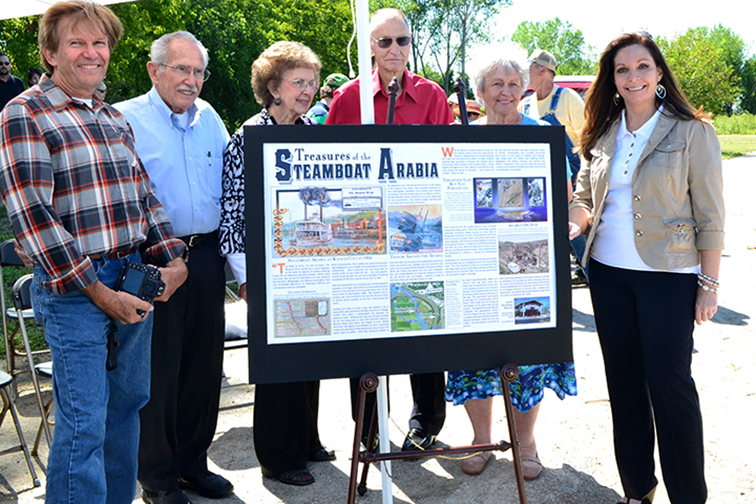PARKVILLE Mo. — Soon, a new trail marker commemorating the sinking of the Steamboat Arabia will sit along a walking trail in English Landing Park, and an even more grand reminder of Platte County’s place in its history could be in the works.
After more than 25 years since the excavation of the famous ship concluded, visitors to the park will know the approximate location of where the Arabia sank more than a century ago. “It’s such an honor to be asked here,” David Hawley, one of the lead excavators on the project, said during a commemoration ceremony Sept. 6. “It’s nice to have the plaque and to be remembered. People walking up and down the river canal can look and say, ‘Oh, this is where the old boat sank.’” Bob, Flo and David Hawley as well as Jerry and Joan Mackey helped unveil a mockup of the actual marker, which features wording from David. The finished product will be installed east of Platte Landing Park in English Landing Park. It will sit directly across the Missouri River from the excavation site, which is located underneath a farm in Kansas City, Kan. due to a shift in the waterway years earlier. The discovery of the vessel along with its restored contents allowed the opening of the Steamboat Arabia Museum currently located in the River Market District of Kansas City, Mo., but with more than 4,000 artifacts recovered, the museum is quickly running out of space as more and more of the items become fully restored. The Hawleys and Parkville mayor Nan Johnson admitted interest in bringing the pieces of boat and its artifacts back closer to where it went down.
“It would be nice if they could relocate here some day,” Johnson said. “We would love to have them. We appreciate the Hawleys doing what they did, which is restoring all the artifacts. They did such a wonderful job.” The remembrance of the sinking of the vessel was part of the Platte County 175th Anniversary Celebration. More than 50 kayakers and canoers paddled down the river from Farley, Mo., to Parkville to set off the event. After the boats arrived, bluegrass music filled the air around the boat ramp. Speeches on the history of the vessel as well as a remembrance of the Lewis and Clark return voyage, which came through Platte County in mid-September 1805 after the famed-explorers reached the Pacific Ocean and returned with maps of the areas visited, were also included. The Hawleys and Mackeys then unveiled the plaque to end the event. Although the parties expressed interest in moving the museum, many hurdles remain before any potential relocation could be made. First is finding enough real estate to hold the artifacts collected from under more than 40 feet of silt and mud , a process which started in 1987. “I research old boats,” David Hawley said. “I went to the library and looked at old newspapers. They said it was coming up the river, and it sank. It was not too far from where we lived. It sounded like a good boat, full of stuff; no lives were lost. So we decided well, let’s go dig it. Well, we had to find it first then one thing led to the next and we couldn’t part with it, so we opened up the museum and have been cleaning artifacts ever since.”




